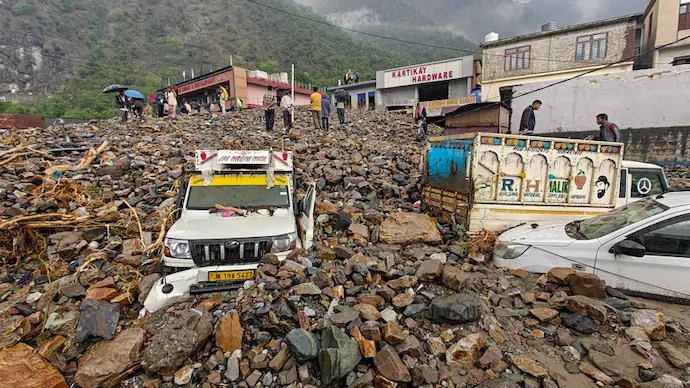Syllabus:
GS-1: Important Geophysical phenomena such as earthquakes, Tsunami, Volcanic activity, cyclones etc.
GS-3: Disaster and disaster management.
Context:
Massive cloudbursts in Jammu and Kashmir’s Ramban district caused heavy flash floods and landslides at multiple locations.
More on the news
- According to the India Meteorological Department (IMD), Jammu and Kashmir received 16.9 mm of rainfall in the 24-hour period ending at 8:30 a.m. on April 20, which is an increase of 575% compared to the normal average of 2.5 mm.
- The natural calamity was accompanied by landslides, hailstorms, and strong winds, resulting in widespread damage to both property and infrastructure.
- The intense weather also led to the blockage of National Highway (NH-44) at several locations, severely disrupting connectivity and transportation.
- A National Disaster Rescue Force team has been deputed on rescue missions in Seri Bagna and Dharamkund villages.
- Deputy Commissioner Baseer-ul-Haq Chaudhary is closely monitoring the ongoing operations in the affected areas, where educational institutions will remain closed until the further notification.
Causes of Ramban’s Flash Floods
- Weather Conditions: As a Western Disturbance approached the Western Himalayan region, the India Meteorological Department (IMD) issued a warning predicting heavy to very heavy rainfall over Jammu and Kashmir.
- Topographical Vulnerability: The topography of the Ramban region in Jammu and Kashmir is such that a strong spell of rain can trigger massive mudslides and landslides. The region is highly vulnerable to flash floods.
Cloud Burst
- According to the India Meteorological Department (IMD), a cloudburst is a localized, extreme weather event characterized by very heavy rainfall over a small area (typically 20-30 sq km) at a very high rate (e.g., 100mm/hr).
- Cloudbursts are more common in hilly areas because of a phenomenon called ‘orographic lift’, which basically means warm air rising up the side of a mountain.
Flash Flood
According to the India Meteorological Department (IMD), a flash flood is a sudden and rapid flooding event that typically occurs within a short period, generally less than 6 hours.
Landslides
As per the National Disaster Management Authority (NDMA), it occurs due to the fast or slow movement of earthy materials (rocks, boulders, soil, etc.) in mountains or hilly regions under the influence of gravity.
The reasons behind the occurrence of landslides are as follows:
- Earthquake
- Heavy rainfall and snowfall
- Anthropogenic activities (unplanned construction activities, forest cutting, etc.)
India Meteorological Department (IMD)

- IMD was established in 1875 to serve as the National Meteorological Service of India.
- It is the principal government agency responsible for all matters related to meteorology and allied subjects.
- IMD functions under the Ministry of Earth Sciences, Government of India.
- Its headquarters are located in New Delhi.
- IMD is also one of the six Regional Specialised Meteorological Centres (RSMCS) designated by the World Meteorological Organisation (WMO).
National Disaster Management Authority (NDMA)
- It was constituted in 2005 by an executive Order of the Government of India. Subsequently, the NDMA was notified in 2006 under the provisions of the Disaster Management Act, 2005.
- The NDMA consists of a chairperson and other members, not exceeding nine.
- The Prime Minister is the ex-officio chairperson and the other members are nominated by the chairperson.
- The chairperson of the NDMA designates one of the members as the vice-chairperson of the NDMA.
- The vice-chairperson has the status of a cabinet minister while the other members have the status of a Minister of State.
- The NDMA is the apex body for disaster management in the country. It works under the administrative control of the Union Ministry of Home Affairs.
Mains Practice Question:
Q: What do you understand by ‘cloudburst’? Explain the mechanism of a cloudburst.
PYQ
Q: Explain the mechanism and occurrence of cloudburst in the context of the Indian subcontinent. Discuss two recent examples. (2022)

